Sure, prairie dogs are cute. But what else do you know about them?
 Photo by: Shutterstock
Photo by: Shutterstock
While most people have at least heard of prairie dogs, many have never seen these animals outside of zoos — unless they live in prairie dog habitat, of course. And even fewer know much about prairie dogs aside from the fact that they pop out of holes in the ground.
Ready to take your prairie dog knowledge to the next level? Let’s go.
What Are Prairie Dogs?
Despite their name, prairie dogs are not canines. They’re actually a type of ground squirrel and belong to the same rodent family as the groundhog. They were called dogs by early explorers because of the barking noises they make to communicate with one another.
Prairie dogs are very social and live in large colonies called “towns.” They make their homes underground in a series of tunnels and burrows. Prairie dog towns can be quite expansive. The largest recorded tunnel system spanned 25,000 square miles in Texas, according to National Geographic. Typically, though, towns cover less than half a square mile.
What Do Prairie Dogs Eat?
For the most part, prairie dogs are herbivores that eat seeds, grasses and other vegetation including cacti. In the fall, they’ll feed on plants like sunflowers, and in winter females that are nursing or pregnant may eat snow in order to get extra water. Prairie dogs will also eat insects.
The specific type of grasses that prairie dogs eat will vary depending on which region of the United States they live in.
Where Do Prairie Dogs Live?
Prairie dogs are native to North America. As their name suggests, they make their homes in prairies. These ground squirrels prefer to live in the grasslands because they’re provided with ample food sources and a clear view of predators.
There are four different species of prairie dogs in the U.S. The species you have in your area will depend on which state you live in. Take a look at which species lives where:
- Black-tailed prairie dog: Arizona, Colorado, Kansas, Montana, Nebraska, New Mexico, North Dakota, Oklahoma, South Dakota, Texas and Wyoming
- Gunnison’s prairie dog: Arizona, Colorado, New Mexico and Utah
- Utah prairie dog: Utah
- White-tailed prairie dog: Colorado, Montana, Utah and Wyoming
Do Prairie Dogs Cause Damage?
Prairie dogs are considered a keystone species, which means other animals in their ecosystem depend on them, whether they do so for food or shelter. If prairie dogs were to go extinct, the ecosystem could change drastically. And, like many burrowing animals, the vegetation and excrement they leave behind can help fertilize grasslands.
However, many farmers see prairie dogs as pests. Their tunneling can ravage fields of crops. They may also eat the crops or chew them down so that they have a clear line of sight and can better spot predators.
Additionally, these animals often feed off the same grasses as cattle. If a large enough group of prairie dogs is dining on the same pasturelands as a farmer’s herd, the cattle have to compete for grass. That means they might not gain as much weight, which can result in farmers fetching a lower price at market.
And farmers aren’t the only people who may think of prairie dogs as a nuisance. Homeowners who live in areas with large prairie dog populations may see substantial damage to yards and gardens. And as they tunnel, they’ll leave behind unsightly mounds.
Prairie Dog Removal
As prairie dogs are social animals, you’re not likely to have just one. Due to the sprawling nature of their burrows, prairie dog removal can be incredibly challenging.
Additionally, Utah prairie dogs are classified as a threatened species and are protected under the Endangered Species Conservation Act of 1969. That means unless you’re a prairie dog expert and can tell each species apart, you could end up with a stiff fine — up to $250,000 — and possibly even face jail time if you harass, relocate, injure or kill a prairie dog or even tamper with its habitat.
And while you may be able to hunt non-protected species of prairie dogs in certain areas of the U.S., the wildlife and licensing regulations will vary depending on where you live. Here again, you can run into very costly fines you don’t want to tangle with, so be sure to check state, local and federal regulations before taking any steps towards prairie dogs removal.
Now it’s likely that you know more about the prairie dog than most people. Interested in other tunneling mammals? Learn all about the pocket gopher.



